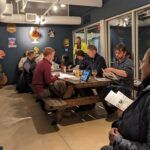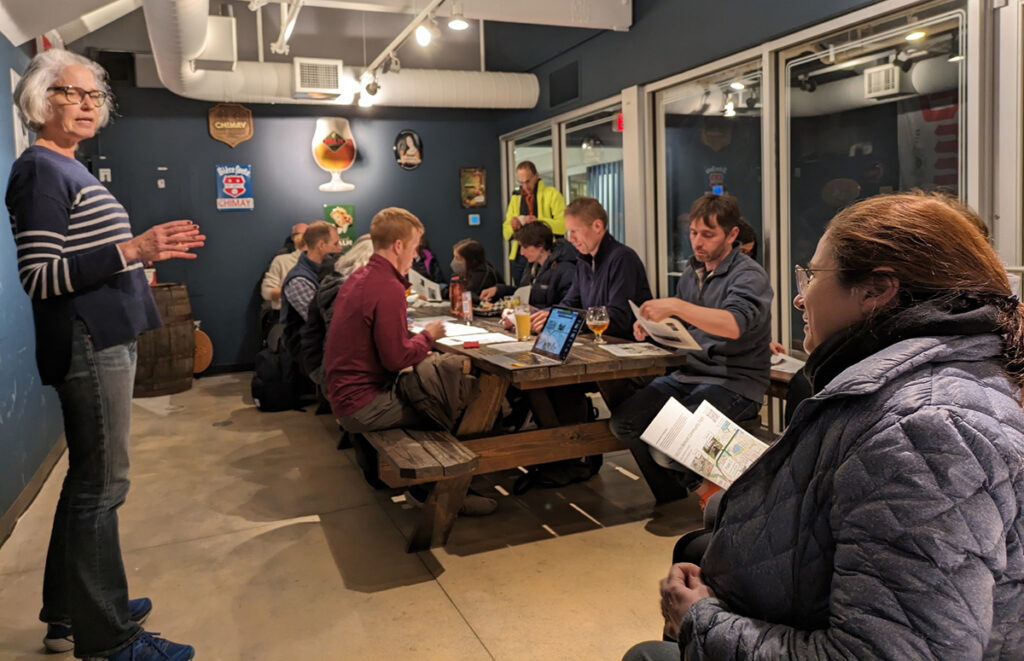
To prepare for the upcoming Design Public Hearing on Phase 1 of the Belmont Community Path, the BCF asked three Community Path experts about what they think about the Community Path project today.
We spoke to Mark Paolillo, Select Board member; Holly Muson, chair of the Community Path Project Committee; and Will Brownsberger, Massachusetts state representative.
BCF
Since you succeeded Russ Leino as chair of the Community Path Project Committee (CPPC) last year, you have had a ringside seat as this project advances. What has most surprised you about the mechanics of advancing the project? Are there lessons from Phase 1 that should inform the town’s approach to Phase 2 (Clark Street bridge to Waltham border)?
Holly Muson
I joined the CPPC in 2019 after attending meetings during the feasibility study for the community path.
As someone who would rather find ways to get around town without using a car, I’m interested in helping to resolve the challenges of constructing a path that will serve Belmont residents of all ages, whether on foot or bike. I took over as chair in the summer of 2023 when Russ Leino moved out of state.
The review process by the various state agencies has taken much longer than we were initially led to expect. Of course, the pandemic probably had some effect. Still, a big part of the complication came from a disagreement between a senior MBTA official and MassDOT engineers regarding the construction method for the underpass at Alexander Avenue and the ensuing need to resubmit design documents. That change happened more than a year into the review process and resulted in requests for a great deal of extra work.
The long duration of the review meant that various state requirements had changed since the original submission, necessitating additional, unexpected work to meet those requirements. The change was a good one in the long run because it will allow for a faster and more efficient construction process and a wider tunnel, making the underpass safer for users.
Looking ahead to Phase 2, we will undoubtedly ask our consultant to meet with the MBTA and MassDOT early and often to identify potential “gray areas” and gain resolution to them ahead of design submission.
For example, if the final route chosen by the Select Board is the one that crosses to the south side of the train tracks, a pivotal question is: what clearance will be acceptable to the MBTA for the bridge over the tracks? The nearby bridges at Trapelo Road and Clark Street are lower (ca. 18 feet) than the current mandated requirements for new construction over MBTA tracks (22.5 feet). Still, there is precedent for the MBTA to make an exception, and we would hope to succeed in an appeal to match the other clearances, resulting in both lower construction costs and an improved user experience.

Holly Muson addresses a community path meeting in November 2023. Photo courtesy of Friends of the Belmont Community Path.
BCF
While MassDOT’s 25% design hearing is a welcome milestone, Phase 1 of the path is over three years behind schedule since it was presented by Nitsch Engineering at a public meeting in July 2020. Can Belmont residents (who are intensely interested in the date of completion) anticipate a faster schedule from here? Do you expect the project will be ready for construction by the TIP-scheduled FFY 2026 timeframe?
Will Brownsberger
The Belmont Community Path project is a top priority of mine, and I am absolutely committed to seeing it through. It will be great for Belmont and great for the region.
The final agreed route for Phase 1 is a clean and straight shot. However, we complicated the project by adding a new tunnel under the tracks. The tunnel will connect the Winn Brook neighborhood to the high school and middle school. The tunnel is a great addition, making the community path more easily accessible from multiple neighborhoods and solving the problem of unlawful track crossings.
However, adding the tunnel introduced additional design variables and also brought the MBTA into the approval process. There was an impasse among engineers in MassDOT and engineers in the MBTA as to how to construct the tunnel.
One option was known as “cut-and-cover,” and the other as “tunnel-jacking.” The cut-and-cover approach is more disruptive of service but makes it easier to build a broader tunnel. Cut-and-cover is also less expensive. Discussions about this went back and forth for quite some time. The issue is finally settled in favor of the cut-and-cover approach, and we will have an ample tunnel. Now that the tunnel construction approach is settled, the way forward is clear. I’m hopeful that there will be no further delays. I’m thrilled that the 25% design hearing is scheduled for March. Scheduling the 25% hearing is a confirmation of substantial consensus about the project among MassDOT engineers.
I’m also thrilled that the Boston Municipal Planning Organization has placed the project on the Transportation Improvement Program for FY2026, which means that it must be advertised for bidding before October 1, 2026.
I do not dare speculate as to when exactly the project will be advertised. One never knows when new problems may emerge. However, I will continue to keep it high on the radar of MassDOT leadership and to bird-dog it diligently through completion.
BCF
Any advice for your successor and the select board going forward?
Mark Paolillo
My advice to current and future Select Board members is that they need to be deeply committed to the completion of the Community Path, all phases. There is strong and broad support among many of the residents in the community for the path. It will enhance the quality of life for our residents and dramatically improve pedestrian and cycling safety as well.
The Select Board needs to work closely with the Community Path Project Committee and other stakeholders in town to deal with any current and future obstacles to completing the path.


Sorry, the comment form is closed at this time.